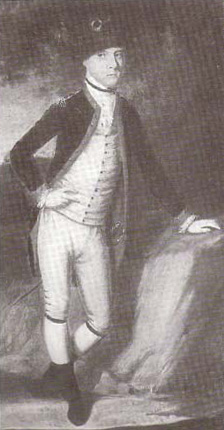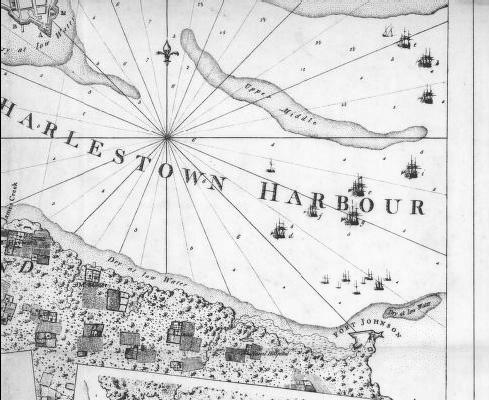Erick Nason, 2ndSouth Carolina Regiment
After the 2nd South Carolina was formed, the first order of business for Captain Marion was to recruit men for the regiment. So he traveled back to his home area of St. Johns and recruited amongst the Huguenots, Scotch-Irish and the English who lived along the Santee, Black and Peedee Rivers. Marion was able to recruit sixty men, to include his nephew Gabriel Marion. By September 1775, Moultrie ordered that Marion’s, Pinckney’s and Elliot’s companies to be immediately filled to fifty men each and made ready to march. At eleven o’clock at night, Marion with Pinckney and Elliot launched for their first offensive operation of the war. They were ordered to secure Fort Johnson which covered the approach into Charlestown Harbor.
Fort Johnson was Charlestown’s principal fort which had been built back in 1747. The fort was located on James Island and had been named after the Proprietary Governor Sir Nathaniel Johnson. The fort was heavily armed, with 7 26-pound, 12 18-pound, a single 12 and a single 9 pound cannons. Additionally, Fort Johnson was the main supply point for Charlestown’s heavy artillery powder stores. The caretaker was a man known as “Gunner” Walker who was no friend of the patriot cause. He had been tarred and feathered by a patriot mob in Charlestown, as well as force to drink “damnation to them all.”
On August 31st, both the 1st and 2nd Regiments were authorized to raise grenadier companies, the grenadier company commanders authorized to hand-selected men from the other line companies. These men would become elite units who would be used for dangerous assignments. For the assault on Fort Johnson, Marion would lead his company of light infantry, Elliot would lead his company of grenadiers, and Pinckney would lead his company of grenadiers. They were to conduct an amphibious landing at night to secure Fort Johnson on James Island which covered Charlestown. Fearing the enemy’s cannon, the boat captain did not land but anchored a little ways off shore. By morning, only the grenadiers were ashore, Marion was still on the water. Motte decided to attack anyways and divided his force into three columns. Each column was o attack a side of the fort, however when they arrived, the fort’s gates were wide open. Gunner Walker and five sailors from the Tamarwas the only garrison there.
All of the guns had been removed from their carriages, but had not been spiked. The garrison had retreated to the British sloops Tamarand Cherokeeexcept for a small stay behind force of sailors. The Royal Governor of South Carolina, Lord William Campbell dissolved the Common House of Assembly and fled to the Tamar.
After taking Fort Johnson, everyone thought the British would leave Charlestown Harbor. The guns of Fort Johnson were repaired and made ready incase the British attempted to retake the fort. Additional men manned the walls and were deployed to meet any British invasion. Instead of attacking, the sloops moved out of range and anchored in Rebellion Road. Both the Provincial Congress and the military authorities began to discuss on what their next course of action should be. They knew that something had to be done to remove the threat of the British naval superiority. They debated if they should construct o fort on Sullivan’s Island, besides Rebellion Road. Lieutenant Colonel Motte was sent to Fort Johnson and another detachment was sent to Mount Pleasant and Sullivan’s Island. This was not done in any secrecy, seeing it was published in the Charlestown paper. During this time Operational Security was never considered like it is today.
The South Carolinians flew their first flag over Fort Johnson on September 15th. The flag was made of blue, with a large silver crescent in the Dexter corner. Colonel Moultrie had the flag made to honor the men of the 1st and 2nd regiments, blue for the uniforms and a silver crescent which the men wore on their helmets. On September 18th, Captain Thornborough of the British Sloop Tamarunderstood the importance of Sullivan’s Island and sent a detachment to keep the island under British control. To cover the British landing, the Tamarfired grapeshot from her 6-pound cannon and from several swivel guns to insure no patriot forces were on the shore. After securing the beach head, the British detachment began to chop down the trees to prevent them from being used in fort construction.
The Tamarwas reinforced when the British sloop Scorpionarrived. On September 19th, Lt. Col. Motte captured a boat bringing supplies to the Tamarby firing one of Fort Johnson’s 6-pounders, then boarding the boat. They captured twenty-one casks of water, once case and two bottles of liquor and some brown sugar. Thornborough was outraged and initiated a blockade of Charlestown harbor with his meager fleet of three sloops.
On September 23rd, the Tamarcaptured the sloop Pollybecause she was found to be transporting a quantity of shot on board. The Polly‘s owners, Benjamin and Isaac Huger were angry, stating that the shot was being used as ballast. Thornborough didn’t buy it and the Pollybecame a tender for the Tamar. Some of the Tamar‘s crew, who had been captured at Fort Johnson, told the patriots that three more warships and a bomb ketch were on their way to Charlestown to attack Fort Johnson. Along with attacking the fort, the ships were going to attack and burn Charlestown like they did up in Boston. The South Carolina Council of Safety took this threat seriously and declared a state of emergency.
Marion’s next action was to move with Captain Huger’s company to Dorchester and reinforce the troops stationed there. Dorchester was a pivotal village some thirty miles up the Ashley River. There, not only were supplies and ammunition stored, but the public records for Charlestown was sent to be safeguarded. There was a local garrison of militia, but there were rumors of Loyalists planning to raid Dorchester. The Loyalists under Colonel Scofield and his Back Country militia were rumored to be preparing to launch this raid. Therefore it was decided to send Marion and Huger there to protect this strategic village. Moultrie himself had selected Marion to lead this important mission.
Captain Marion, along with Lieutenants Baker, DuBose, and Shubrick with sixty-four men of Marion’s company, and thirty-eight men from Huger’s company marched off to Dorchester. Soon the town and its important arsenal was secured and put into a sound state of defense. However, the Loyalists failed to appear and the men began to settle into guard duty. This duty soon began to become monotonous and by December 10th, 1775 Marion had lost forty-five men to sickness and desertion. It was around Christmas that Marion had enough of guard duty and requested to be reassigned. Colonel Moultrie consented and ordered Marion to return to Charlestown to help rebuild Fort Johnson. Soon the men of the 2nd South Carolina along with their other comrades would soon face the British in a real fight.
Major General Charles Cornwallis had begun preparing five regiments for a campaign in the southern colonies. Governor Rutledge decided to fortify the harbor entrance to Charlestown, and ordered the 2nd South Carolina to move to Sullivan’s Island. On February 10th, 1776 Marion and the same men he had commanded in Dorchester, encamped at Haddrell’s Point. Understanding they needed more men for the defense of the city, two regiments of riflemen were ordered to be formed. The members of the Provincial Congress selected Colonel Isaac Huger, Lieutenant Colonel Alexander McIntosh and Major Benjamin Huger for the 1st Regiment of Rifles. Thomas Sumter was selected as Lieutenant Colonel of the 2nd Regiment of Rifles. With the promotion and transfer of Major McIntosh, there was an opening in the 2nd South Carolina. Due to his reputation for hard work, faithful service and seniority, Francis Marion was promoted to Major in the 2nd South Carolina.
On 10 May 1776 Jacob Shubrick became a first lieutenant in the
2nd South Carolina Regiment and was in the battle of Fort Sullivan on 28 June 1776.
He was transferred to the regiment’s light Infantry company 16 July 1777 and was promoted
to captain on October 1777 when Captain Oliphant resigned.
He died on 27 April 1778 of smallpox.
Chart showing Fort Johnson situated in Charlestown harbor.
Due to the forts commanding position within the harbor, it is easy to see why it had to be taken.

